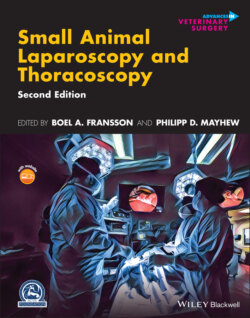Читать книгу Small Animal Laparoscopy and Thoracoscopy - Группа авторов - Страница 139
Adoption into Veterinary Laparoscopy
ОглавлениеWithin veterinary laparoscopic surgery, reducing the number of portals of entry has been a concept embraced by many veterinarians for a number of common techniques. In 2009, Dupre et al. described the one portal operating laparoscopic ovariectomy (OVE) using a 10‐mm telescope that incorporates a working channel that can accommodate 5‐mm instruments [21]. An array of two‐port laparoscopic‐assisted techniques, including gastropexy [22], cystopexy [23], urinary calculi removal [24], and cryptorchidectomy [25], have also been described. These two‐port techniques enabled many common elective procedures to be done routinely by veterinary laparoscopic surgeons. It was only recently that many of the two‐port procedures in veterinary laparoscopy took a leap toward the single‐port platform in which multiple instruments, as well as the telescope, are consolidated to one point of entry for completion of the entire procedure. The earliest abstract reports on laparoscopic single‐port veterinary techniques that did not use an operating laparoscope emerged in 2011 [25, 26]. The single‐port platform gained rapid popularity among veterinary laparoscopic surgeons. Shortly after the initial single‐port abstracts, a total laparoscopic ovariectomy using standard rigid instrumentation was described [27] using a commercially available single‐port device (SILS [single‐incision laparoscopic surgery] port, Covidien, Mansfield, MA). Shortly after, the SPA ovariectomy technique was reported [28]. Other single‐port devices, as well as novel bent and articulating instruments, emerged as feasible instrumentation that could be used in veterinary single‐port laparoscopy [29]. More recently, other techniques using the LESS approach have been reported and are summarized in Table 6.2.
Table 6.2 Examples of procedures that have been adopted with single‐port, single‐incision, and LESS in clinical cases within veterinary surgery.
| References | |
| Ovariectomy in dogs and cats | [20, 27, 28,30–35] |
| Ovariohysterectomy | [36] |
| Cryptorchidectomy | [37, 38] |
| Intestinal surgery | [34,39–44] |
| Adrenalectomy | [45] |
| Splenectomy | [46, 47] |
| Artificial urethral sphincter placement | [48] |
| Gastropexy | [22,49–52] |
| Cholecystectomy | [53–55] |
| Ureteronephrectomy | [56] |
Despite the wider adoption of single‐port surgery in veterinary medicine, there has been little comparative analysis of the potential advantages or disadvantages to conventional, multiport laparoscopic surgery. A retrospective case series reviewed multiport and a SPA system for a variety of laparoscopic procedures [57]. Surgical time and intraoperative complications were found reduced for patients undergoing single‐port surgery. Conversely, a prospective, randomized trial comparing multiport and single‐port ovariectomy demonstrated that surgical difficulty was subjectively higher for single‐port surgery [58]. Complications were, however, not identified in any case (0/10). Given the additional technical challenges, different and often expensive disposables required, and potentially longer learning curve, additional study is warranted on the value and safety of LESS over existing techniques.
